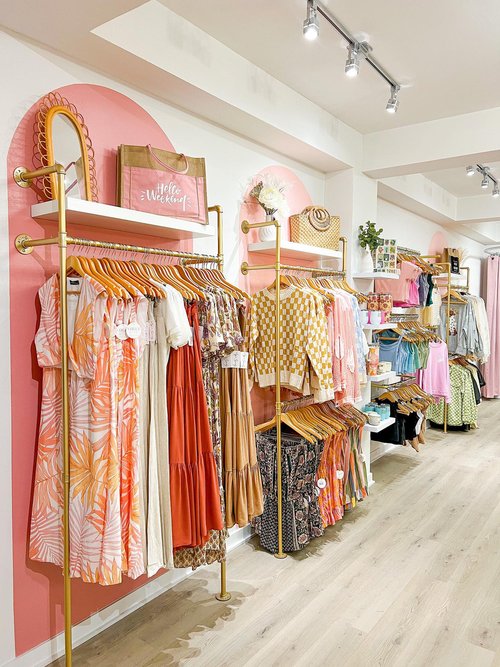Lasting Fashion: Just How Eco-Friendly Clothing Is Shaping the Future of Design
As the apparel industry deals with raising examination over its ecological influence, the increase of lasting style provides an encouraging alternative that aligns style with environmental responsibility. Utilizing cutting-edge materials such as plant-based textiles and recycled fibers, alongside sophisticated methods like electronic and 3D printing, developers are redefining what it indicates to be stylish in the modern age. Simultaneously, the growing popularity of upcycling and second hand culture is cultivating a shift towards a round economic situation. Yet, exactly how does this motion absolutely affect the future trajectory of style, and what obstacles lie in advance in its extensive fostering?
Innovative Sustainable Products
As the style industry comes to grips with its ecological influence, innovative sustainable materials have emerged as a vital option for minimizing eco-friendly footprints. Amongst one of the most appealing materials are those originated from all-natural, renewable resources, such as organic cotton, hemp, and bamboo. These materials not just reduce dependence on nonrenewable fuel sources yet likewise lessen damaging pesticide use and water consumption. Organic cotton, for circumstances, uses significantly less water than standard cotton and eliminates the requirement for harmful chemicals, therefore maintaining dirt wellness and biodiversity.
In enhancement to plant-based products, innovations in biofabrication have actually led to the development of lab-grown textiles. Mycelium leather, originated from mushroom roots, presents a versatile and biodegradable alternative to animal natural leather. Its production results in considerably lower carbon emissions and water usage, making it a more sustainable option for stylist looking for to align with green practices.
Recycled materials are additionally acquiring grip, with polyester made from recycled plastic containers standing for a considerable breakthrough. This development not only diverts plastic waste from land fills and seas yet also minimizes power intake compared to creating virgin polyester. With each other, these products emphasize the capacity for a much more sustainable fashion business, paving the method for environmentally aware style and production.
Eco-Conscious Manufacturing
Structure on the developments in lasting materials, the fashion sector is likewise re-evaluating its manufacturing processes to better minimize ecological effect. Secret techniques consist of minimizing water usage, reducing carbon discharges, and removing dangerous chemicals.
An additional vital aspect is the reduction of poisonous chemicals generally used in dyeing and ending up textiles. Eco-conscious makers are shifting towards plant-based dyes and waterless dyeing innovations, which not just secure local ecosystems but additionally boost worker security. Innovations like digital printing lower textile waste and energy intake, using a cleaner alternative to standard methods.
Moreover, transparency and traceability have become paramount. With the development of blockchain innovation, business can now offer in-depth insights into their supply chains, guaranteeing ethical and environmentally friendly techniques at each action. This transparency constructs customer depend on and motivates brands to maintain high sustainability criteria. As the need for eco-conscious products grows, suppliers are urged to innovate, guaranteeing that the future of fashion is both fashionable and lasting.
The Increase of Upcycling
Upcycling, a transformative technique in lasting fashion, involves creatively repurposing disposed of products right into new, high-quality products. This innovative strategy not just lowers waste however likewise lessens the need for raw materials, thus reducing the environmental influence of clothing manufacturing. By reimagining and reconstructing existing items, developers and style brands are able to instill originality into their collections while advertising ecological duty.

Additionally, the upcycling movement has actually empowered independent designers and small organizations, who frequently lead in advancement due to their agility and creativity. By maximizing the plentiful availability of unused products, these entities add to a round economic situation, showing that fashion can be both fashionable and sustainable. Through upcycling, the sector takes considerable strides towards an extra accountable and conscious future.
Thrift Society's Effect
The growing second hand culture considerably reshapes the landscape of lasting fashion, emphasizing the value of mindful intake. This click now cultural change motivates consumers to welcome used clothes, thereby decreasing the demand for new garment production and minimizing ecological impact. Second hand shopping not only extends the lifecycle of garments however additionally reduces the carbon impact associated with manufacturing, moving, and taking care of clothing.
An essential facet of second hand culture is its democratization of style. By supplying a vast range of designs from numerous periods at budget friendly rates, thrift stores make fashion available to a broader target market. This access cultivates a feeling of individuality and creativity, as customers mix and suit special pieces to curate personalized wardrobes without adding to the fast fashion cycle.
Additionally, second hand society promotes circularity in vogue, lining up with the concepts of a circular economy. By recirculating garments, the cycle of waste is disrupted, and sources are preserved. This technique sustains a change from a straight "take-make-dispose" version to an extra lasting structure. As even more designers and consumers welcome second hand culture, the fashion business is urged to adjust, incorporating lasting techniques to fulfill the growing demand for eco-conscious choices.

Future Trends in vogue
Fashion's development is significantly formed by technical innovations and sustainability-driven initiatives. As consumers end up being much more eco mindful, the market is reacting with groundbreaking advancements that redefine the future of style. One prominent fad is the increase of electronic fashion, where digital garments can be used in increased reality settings, dramatically decreasing textile waste. This shift not only accommodates the digital-savvy consumer however additionally reduces the ecological footprint traditionally related to garment manufacturing.
In addition, the integration of blockchain technology uses new opportunities in transparency and traceability, enabling consumers to validate the sustainability credentials of their garments. boutique fashion. This ensures liability in supply chains and promotes moral sourcing techniques. 3D printing is yet another innovation that promises to change manufacturing procedures by enabling on-demand manufacturing, thus reducing excess stock and waste
In addition, the development of bio-fabricated products, such as lab-grown natural leather and plant-based fabrics, presents lasting alternatives to standard materials. These innovations reduce dependence on animal products and resource-intensive crops. As these innovations develop, they are poised to change the style landscape, merging style with sustainability. The future of style, for that reason, exists in a seamless blend of innovation, innovation, and ecological obligation.
Final Thought
The improvement of the fashion market via sustainable techniques suggests a pivotal change towards ecological responsibility. This evolution not only straightens style with eco-friendly sustainability learn this here now but additionally establishes a precedent for future patterns focused on duty and development.
As the style industry encounters enhancing scrutiny over its ecological impact, the increase of sustainable style supplies an appealing alternative that straightens style with eco-friendly obligation.As the style industry grapples with its environmental impact, cutting-edge lasting materials have arised as an essential remedy for decreasing environmental footprints. Together, these materials highlight the capacity for an extra lasting style sector, paving the way for eco mindful style and manufacturing.
Structure on the developments in sustainable products, the fashion sector is additionally re-evaluating its production procedures to additionally official source lower ecological effect. boutique fashion.Upcycling, a transformative method in sustainable fashion, involves creatively repurposing thrown out products right into new, high-grade items